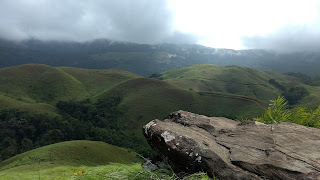Forests - In need of protection today
Karnataka is home to the diverse forests including the famed Western Ghats that cuts a swathe through more than nine districts while nurturing some of the most fascinating landscapes man has ever known. These forests harbour a bewildering wealth of flora and fauna: mammals, birds, reptiles, amphibians, and fresh water fishes; much of which is endemic to the region. As early as 1988, people like Myers mentioned that the high level of diversity and endemism in Western Ghats has given it the status of one of the biodiversity hotspots of the world. Forests in Karnataka are spread across landscapes ranging from Evergreen, Semi Evergreen, Moist, Dry and Shola forests resulting in a paradise for botanists, researchers, tourists and forest lovers in general. These forests are the source of several rivers, streams, swamps and marshes cumulatively bringing water to the parched land and ensuring a lifeline to millions across the state.
Often, forests mean many things to many people. It is a source for food for some, supply of medicinal plants for others and a valuable economic source of timber for many. All these are traditional demands that have been met by the forest since life began on earth. There would be infact few forests that do not provide benefits to either man or animal, in one way or the other. This role of the forest as a mutual agent of assistance is acknowledged by millions countrywide. For them, the forest is the omnipresent philanthropist, always ready to give.
However, even the most generous donor has a threshold and the wild is in a terminal decline today, leading to an ever increasing clamour to protect these fragile resources. Citizens, especially those who receive the benefits of forestry resources sitting in distant locations have grudgingly acknowledged that these resources need to be conserved, providing a significant urban based push for the environment movement over the past few years. There are a plethora of voices when it comes to focussing on reversing degradation of natural resources. Some advocates of conservation promote exclusion of forest dependent people from their homes in the so-called larger interest of the society, a concept that is opposed by groups who actively demand that indigenous people be allowed to stay in their ancestral lands and allowed to have rights over these lands.
This leads us to question whether forests are to be conserved for the benefit of urban conglomerations in commercial markets or is it to be conserved for people who live in adjacent areas and subsist on them, or is to be conserved to protect the invaluable wild flora and fauna that enrich the planets’ biodiversity.
These issues are related to the ownership, use and management of the forests. How will the resources be utilized and by whom, for whom? The State, representing many interests, including that of the demand of the distant consumer has larger concerns in mind to meet the larger objectives. Dams, logging, mining and large projects are undertaken to meet these goals and permanently alter these areas and their ecology. On the other hand, the forests are home to indigenous communities who have traditionally been dependent upon natural resources, utilizing and surviving on forest resources for a long period of time. These are some of the pulls and tugs that forest areas are now subject to.
This is a wide variety of choices people have made for themselves, forgetting that the forests inherently comprise three elements – flora or trees and shrubs, fauna or animals and man. These three are intrinsic to the very identity of the forests. But in the divide between many interest groups, it is easy to focus on the importance of any of these three components individually. Through an isolated window, focus on either one of the three is likely to lead to an imminent collapse of the forest ecosystem. Forests will then cease to exist as they do now and remain but a mere plantation or a forest village or a zoo or a research station, for the three complement each other and the alienation of one will inevitably alter the character of the forests as we know them. Just as it is necessary to provide a safe refuge to the diverse fauna, it is difficult to ignore the communities who have traditionally lived by the forests and accessed it for their livelihood. Can they be made partners in forest management and continue to protect its resources, undertaking the least damaging activity of NTFP collection, rather than large scale mutilation of forest regions. It is indeed difficult to imagine The Bilgiri Rangana Sancturay without the Solegas or parts of Uttar Kannada without the Siddhis. Of course, a need to provide inviolate spaces need to be provided in some national parks and people may be asked to relocate but these incidences are few and far between. Indigenous people should therefore be allowed to stay within their traditional domains and not shifted due to the misjudged perception of some, especially based on general sweep that categorises all of them as being inordinately exploitative in nature. The indigenous people, if made a modern day guardian, will result in being the pre-eminent defender of the forest, augmenting the efforts of the solitary forest guard, significantly.




Comments